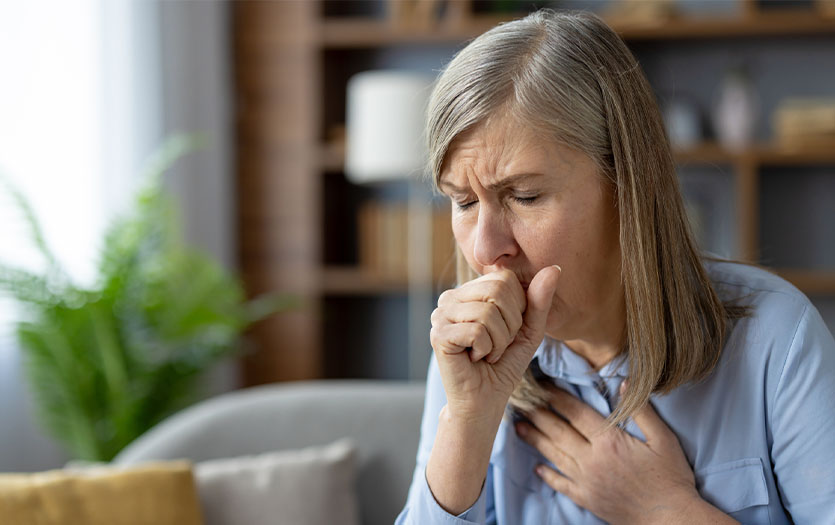
This post was written by Dr. Tamara Kermani, PPG-Family Medicine.
While smoking is the leading cause of chronic obstructive pulmonary disease (COPD), the disease can also affect people who have never smoked. According to the American Lung Association, a quarter of individuals who have developed COPD are in this category. This common misconception can cause patients to overlook early symptoms and delay treatment that could help preserve their lung function.
An overview
COPD is a group of airway diseases that vary from mild to very severe. The two main forms are emphysema and chronic bronchitis. These conditions usually result from scarring and inflammation of the lungs.
Due to airflow limitation from scarring and/or inflammation, air cannot travel out of the lungs. This impeded flow causes air to be retained in the lungs, leading to complications such as shortness of breath, wheezing and decreased exercise capacity.
Who is at risk?
Although COPD is primarily found in people who have a history of smoking, it's not uncommon for it to develop in people who have been exposed to various chemicals that may cause lung sensitivity. This includes people who have been around secondhand smoke. The workplace is another source of contaminants, like dust, chemicals, fumes, wood smoke and other pollutants.
In addition to environmental pollutants, there are also genetic components that can increase the risk of COPD. For example, a condition called alpha-1 antitrypsin deficiency occurs when the body does not form enough of the protein responsible for protecting the lungs from damage. People who have had a history of lung damage from other issues, a history of asthma, and those who are older than 40 are also at an increased risk for developing COPD.
What are the key warning signs and symptoms?
Some of the most common signs and symptoms of COPD are:
-
Shortness of breath
-
Wheezing
-
Chronic cough
-
Frequent lung infections
-
Coughing up sputum (which can be clear, white or greenish)
Individuals with COPD often experience fatigue alongside these symptoms because their body is not getting enough oxygen and has to use more energy to breathe. In more advanced cases, decreased appetite and weight loss can occur due to the increased metabolic demand and strain on the body.
What makes these symptoms dangerous is how easily they can be attributed to less serious issues. Many people believe they can't walk as far as they used to, simply because they are getting older or have gained weight. They may think that their increased shortness of breath or cough is "normal in a smoker" and nothing to worry about.
People often attribute recurring lung infections, like bronchitis, to the weather, seasonal changes, or circulating viruses, overlooking that these could indicate a more serious condition.
COPD is progressive, meaning symptoms often become more severe over time. Because women tend to have less lung capacity and smaller airways in comparison to men, they may experience more shortness of breath at earlier stages. The disease also progresses faster in women, and they may struggle more with cough and mucus obstruction. Men however frequently report experiencing more fatigue with their COPD.
What should someone do if they notice COPD symptoms?
Anyone who notices COPD symptoms should immediately make an appointment to see and discuss their symptoms with their doctor. Even if they think that they do not have traditional risk factors for COPD, they could instead have a genetic propensity for the disease that can only be determined through a blood test.
In other instances, an explanation for why certain people develop COPD is never found, but it could be due to environmental factors when they were younger or as a child. The only way to definitively diagnose COPD is through testing, such as lung function testing or imaging, which a doctor can order if there is a suspicion.
How is COPD typically treated and managed?
Treating and managing COPD depends in large part on the specific symptoms involved and the severity. It is crucial to look at the patient as a whole and consider their age, general overall health, lifestyle and other health issues before determining a treatment plan.
For the majority of patients, treatment includes various inhalers. These deliver medicine directly into the lungs to help open up the airways. The mainstay of most COPD treatments includes regular use of inhaled medications that are longer acting, once or twice a day, in combination with shorter-acting "rescue" medications to use as needed during a flare-up.
Other medications may include:
-
Oral steroids during exacerbations or flare-ups. Sometimes steroids are prescribed for daily use in patients with more severe disease that does not respond to inhaled medications alone.
-
Selective phosphodiesterase-4 (PDE4) inhibitors are a new category of oral medications that can help block an enzyme that worsens lung swelling. Daliresp® (roflumilast) is the most commonly used medication in this category.
-
A biological injection called Dupixent®, which was primarily used for asthma, has now been approved for use in COPD. These medications are generally used only if patients do not respond well enough to the inhaled medications.
-
Antibiotics are typically prescribed during flare-ups, but in some patients with more severe disease, daily antibiotics have been found to help prevent exacerbations, reduce inflammation and decrease hospitalization.
Other therapies that can contribute to managing COPD consist of:
-
Pulmonary rehab is a comprehensive program that includes respiratory therapists and nutritionists. It can teach patients how to breathe more efficiently, optimize nutrition and improve exercise tolerance.
-
Staying up-to-date with immunizations, particularly for the flu, COVID, pneumonia and RSV, can reduce the risk of serious infections.
-
Supplemental oxygen when levels drop too low. For some, this is only during increased activity, but others may need oxygen continuously.
-
Surgical interventions like lung volume reduction shrink the lungs and help with better air delivery.
Final thoughts
The most important thing to remember is that COPD is different in everyone and requires an individualized treatment plan. If you or someone you love displays symptoms of COPD, don't hesitate to speak with a primary care provider. Timely intervention can potentially slow the progression of the disease and improve overall quality of life. If you need help scheduling an appointment or establishing care with a provider, our Access Center can help. Call any time, at 877-PPG-TODAY or 877-774-8632 for assistance.
This content originally appeared in Women's World magazine in July 2025 and has been adapted for the Parkview Dashboard.



